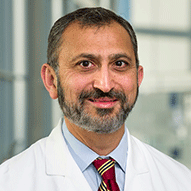Adolescent Ovarian Cysts and Tumors
Often ovarian cysts and tumors in children and teens are problem free. But when your daughter is in pain or has other worrying symptoms, our pediatric and adolescent gynecologists can provide compassionate, expert care to treat her condition — and ease your concerns.
What are Adolescent Ovarian Cysts and Tumors?
Ovarian cysts and tumors may occur at any age but are most common between puberty and menopause. Some cysts, or fluid-filled sacs, develop during a girl’s normal period. Often, they go undiagnosed or will dissolve on their own. In most cases, ovarian cysts are tiny, but they can grow larger in some circumstances. In other cases, ovarian cysts occur in combination with solid tumors and require surgical removal while preserving the ovary.
What are the different types of Adolescent Ovarian Cysts and Tumors?
There are two main classes of ovarian cysts and tumors.
Functional cysts and tumors
Functional cysts are part of the normal menstrual cycle and include:
- Follicular cysts and tumors are the most common type of functional cysts and tumors. They are formed when an egg is maturing on the ovary.
- Corpus luteum cysts and tumors can form on an ovary kind of like a "bruise" after ovulation. Occasionally, they can cause some minor pain.
Nonfunctional cysts and tumors
Nonfunctional cysts and tumors aren't related to the menstrual cycle. They include:
- Cystadenomas are cysts that develop on the ovary's surface and are filled with a thin, watery fluid or a thick, mucous-like material. These are usually benign.
- Dermoid cysts (teratomas) form from embryonic cells and can contain hair, skin or teeth. These are usually benign but can become large and can twist, causing pain.
- Endometriomas develop due to endometriosis. Uterine endometrial cells grow outside the uterus, which can attach to the ovaries and form cysts and tumors.
What are the signs and symptoms of Adolescent Ovarian Cysts and Tumors?
Symptoms of functional cysts and tumors are rarely noticed, and often disappear on their own within two or three menstrual cycles. If a cystadenoma or a dermoid cyst becomes large, it can move the ovary.
Possible Complications
Complications may occur in some cases and can include:
- Ovary rupture – Large cysts may cause the ovary to leak, which can lead to hemorrhaging and pain.
- Hemorrhage – Internal bleeding may occur if the cyst bursts.
- Torsion (twist) – Cysts can move the ovary, causing it to twist. Torsion causes severe pain, nausea and vomiting. It can also decrease or even stop blood flow to the ovary, requiring emergency surgery.
How are Adolescent Ovarian Cysts and Tumors diagnosed?
If you suspect your daughter has ovarian cysts or tumors, her doctor will first take a medical history and conduct a physical exam. A pelvic exam will not be required, but her doctor will want to know when her last period was and how regular her periods have been.
Additional tests may include pelvic imaging studies such as an Ultrasound and CT Scan.
What are the causes of Adolescent Ovarian Cysts and Tumors?
Most ovarian cysts and tumors develop as a result of the normal menstrual cycle. Risk factors include:
- Endometriosis
- History of ovarian cysts and tumors
- Pelvic infection
How are Adolescent Ovarian Cysts and Tumors treated?
Small cysts and tumors are usually normal, while the larger ones may require removal. Often, removal can be done with minimally invasive (laparoscopic) surgery by a pediatric and adolescent gynecologist. This approach saves the ovary.
Ovarian tumors in children are most often benign.
Occasionally, ovarian tumors and cysts cause twisting of the ovary and fallopian tube. In these cases, they are found when a patient is evaluated for abdominal pain. Twisted ovaries require prompt surgery to prevent damage to the ovary from lack of circulation.
Adolescent Ovarian Cysts and Tumors Doctors and Providers
-
 May Lau, MD Adolescent Medicine Specialist
May Lau, MD Adolescent Medicine Specialist -
 Adam Alder, MD Pediatric Surgeon
Adam Alder, MD Pediatric Surgeon -
 Nathalie Brewer, MD Pediatric Surgeon
Nathalie Brewer, MD Pediatric Surgeon -
 M. Brett Cooper, MD Adolescent Medicine Specialist
M. Brett Cooper, MD Adolescent Medicine Specialist -
 Natasha Corbitt, MD Pediatric Surgeon
Natasha Corbitt, MD Pediatric Surgeon -
 Nirupama De Silva, MD Pediatric Gynecologist
Nirupama De Silva, MD Pediatric Gynecologist -
 Diana Diesen, MD Pediatric Surgeon
Diana Diesen, MD Pediatric Surgeon -
 Jenny Francis, MD Adolescent Medicine Specialist
Jenny Francis, MD Adolescent Medicine Specialist -
 Jason Jarin, MD Pediatric Gynecologist
Jason Jarin, MD Pediatric Gynecologist -
 Stephen Megison, MD Pediatric Surgeon
Stephen Megison, MD Pediatric Surgeon -
 Joseph Murphy, MD Pediatric Surgeon
Joseph Murphy, MD Pediatric Surgeon -
 Samir Pandya, MD Pediatric Surgeon
Samir Pandya, MD Pediatric Surgeon -
 Faisal Qureshi, MD Pediatric Surgeon
Faisal Qureshi, MD Pediatric Surgeon -
 Mark Ryan, MD Pediatric Surgeon
Mark Ryan, MD Pediatric Surgeon -
 Lauren Gillory, MD Pediatric Surgeon
Lauren Gillory, MD Pediatric Surgeon -
 Erik Su, MD Adolescent Medicine Specialist
Erik Su, MD Adolescent Medicine Specialist